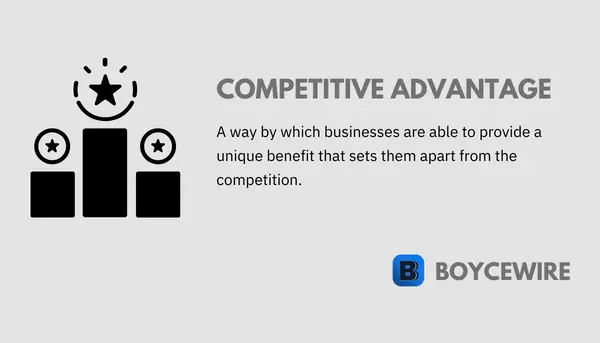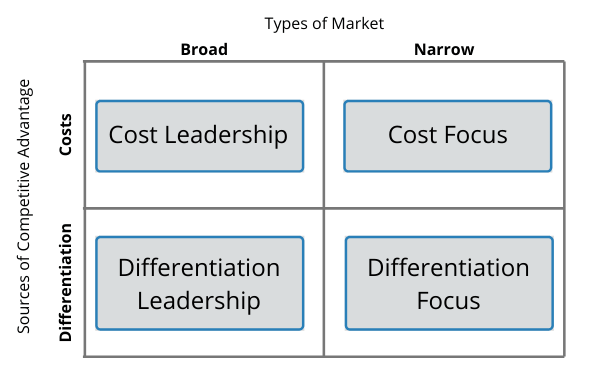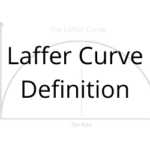Competitive Advantage: Definition, Types & Examples

What is Competitive Advantage
A competitive advantage is where one business has an edge over another. In other words, it is what makes the business stand out from other competitors in the market. For example, a business may have a competitive advantage due to its brand image, technological expertise, customer service, or a distribution network.
By having a competitive advantage, the business and its products/services become more attractive to the consumer. This may be because it can offer lower prices, a better-quality product, or superior customer service. In economics, this is known as the value proposition.
The value proposition is simply the various factors that consumers consider when placing a value on how much they are willing to pay. For example, when buying a car, the consumer may consider acceleration, colour choice, reliability, and price – thereby making up the value proposition.
Key Points
- A competitive advantage is what sets one business apart from another.
- When a firm has a competitive advantage it is part of its value proposition, which helps consumers place an amount on their willingness to pay.
- A firm may have a competitive advantage in four main ways: cost focus, cost leadership, differentiation leadership, and differentiation focus.
A business has a competitive advantage when it is able to offer a superior option to customers among one of these value propositions. For instance, one car manufacturer may offer a 20-year warranty as it is highly reliable. Other car manufacturers may only offer a 2-year warranty, thereby providing the consumer with a greater value proposition and demonstrating its competitive advantage.
Types of Competitive Advantage
There are three generic types of competitive advantage that Michael Porter set out in his book, “Competitive Advantage: Creating and Sustaining Superior Performance.” They are Cost Leadership, Differentiation Leadership, and Focus, which is divided into cost and differentiation focus.

Cost Leadership
When a company has a competitive advantage through cost leadership it focuses purely on price in order to become the lowest-cost producer in the market. By extension, this allows it to charge the lowest prices to attract consumers – thereby providing it with a competitive advantage.
This type of competitive advantage is also known as a ‘no-frills’ approach. As cost is the key factor in this strategy, firms often ignore factors such as quality and reliability. As a result, this may affect brand image and customer retention if it leads to unhappy customers.
Under a cost leadership strategy, the company focuses on improving operational efficiency, which in turn reduces the cost per unit. For instance, it may look to minimize the number of workers, introduce new processes, and improve supply chain efficiency. The key focus here is not necessarily on the product, but rather how much it costs to produce. In turn, this can lead to lower costs for consumers, but may also lead to poor quality goods.
Most companies that operate under this strategy only do so if they can fully utilize economies of scale. For small niche markets such as diamond-encrusted phone cases, it isn’t so feasible. Instead, mass markets such as retail tend to operate this strategy. Examples include Walmart, Aldi, and Carrefour.
Differentiation Leadership
Differentiation leadership is where businesses use a unique selling point to distinguish themselves from the competition. Firms offer a different value proposition from their competitors in order to attract customers. For example, if the price is higher, then the unique selling point will help justify the price tag.
Companies operating under a differentiation strategy are often the first to exploit new trends in the market. For example, Apple led the way with the revolutionary iPhone which has changed the way we consume media and entertainment. Through its differentiation approach, it has established itself as a world leader in the smartphone market – whilst also enhancing its brand image.
Differentiation can come in many forms, some of which include high quality, superior customer service, better features, or reliability. It can simply refer to anything that makes a good different from the competition. In turn, this can help the firm attract customers who are looking for quality and are willing to pay for it.
Whilst a differentiation strategy can help set the firm out from the competition – it is not necessarily enough. For instance, a new restaurant may make the best pork ribs in the country, yet it may very well go out of business within the year. The reason being is that nobody knows they are the best ribs. So without a successful marketing campaign that highlights the unique selling point to customers, this strategy may not fare so well.
Focus Strategy
A focus strategic approach covers both a cost and differentiation focus. It differs from the other two types of competitive advantage in the fact that it targets niche markets. Whilst cost and differentiation leadership target the whole market, a focus strategy targets a small segment. Examples include stores for left-handed people, vegan shoes, or pubs for animals.
This type of strategy specifically targets a certain demographic in the market which has specific needs. Generally speaking, these are small markets that new companies can come and take advantage of due to the lack of competition. In turn, it allows small firms the opportunity to operate without fierce competition from large firms that can compete on price.
Firms that operate a focus strategy tend to gain a competitive advantage by targeting a specific need of the consumer rather than their sensitivity to price. Due to the small size of the market, it means that it is often under-served which results in consumers willing to pay higher prices. At the same time, there is also limited competition and, in some cases, can classify as a natural monopoly.
Examples of firms using a focus strategy include Bakon Vodka, a firm that sells bacon flavoured vodka. There are also a number of firms that sell jewellery especially for cats. Coming back to a more sensible example, we have the use of local short-haul flights. For instance, Southwest Airlines in the US provides bespoke transport between airports. Therefore, by focusing on a specific part of the market, such firms are able to distinguish themselves from big players that are more broad in focus – thereby obtaining a competitive advantage.
Examples of Competitive Advantage

1. Brand Image
A company brand represents the trust consumers have in it. A brand with a bad image means that consumers do not trust it to provide them with a quality product. For instance, Samsung faced a disaster when it had to recall its Galaxy Note 7 after the lithium-ion battery exploded whilst charging. There was also Volkswagen’s emissions scandal whereby it fabricated tests to comply with regulatory standards.
Both cases led to lower sales because of the damage to the firms brand images. Yet on the other side, we have brands such as Apple and PlayStation. Both inspire such brand loyalty that customers flock to buy them regardless.
2. Customer Service
When customers purchase a product and need to return it due to a fault or some other reason, they will have to go through customer service. That experience may be so painful that customers may never come back again. Yet if the process is smooth and customers get a refund quickly and reliably, it can enhance the brand and increase its standing.
There is also general customer service in customer-facing roles. For example, this might be a call center, a restaurant, or a retail store. Companies that offer superior customer service in these markets will often find themselves ahead of the competition. For instance, Amazon has an efficient returns policy and deals with complaints in good time – which is why it has managed to dominate the market for so long.
3. Corporate Management
It’s not only important to have a superior product, but also a motivated and organized workforce. CEO’s make important multi-million-dollar decisions on a daily basis. At the same time, the rest of management will also take financial decisions on a smaller scale. If management is incompetent, then these costs will filter through into the final price to consumers.
It’s also important to consider the impact that management has on its workers. For instance, if they don’t motivate staff, it can lead to lower quality service, inefficient workers, and higher turnover. Subsequently, this impacts on the customer experience as well as the bottom line for the company.
Firm’s such as Apple, Microsoft, and Google all have great corporate management and therefore a competitive advantage over many other companies.
4. Distribution Network
A sophisticated distribution network allows the firm to get goods to suppliers and buyers in good time. This can be crucial, especially for time-sensitive goods such as fresh food. By getting these goods to suppliers and consumers rapidly, firms are able to put themselves ahead of their competitors.
For example, Amazon revolutionized online shopping with its next-day delivery service through Amazon Prime. Millions of people across the world now pay a yearly subscription for the benefit – all thanks to Amazon’s sophisticated distribution network. This network has become such a huge asset to Amazon that it’s probably the firms biggest competitive advantage. It’s something that few others could replicate, especially not in a short space of time.
5. Economies of Scale
As a firm grows, it is able to benefit from economies of scale and lower unit costs. This can translate into a distinct cost advantage as it can charge lower prices to consumers. At the same time, the firm may also benefit from an increase in brand exposure as it grows larger.
Economies of scale is quite a broad competitive advantage. In markets such as supermarket retail, large firms such as Walmart, Kroger, Publix, all have a massive advantage over its smaller competitors. The leading players are able to benefit from lower costs, which is effective creates somewhat of a closed market. Leading firms are able to price products at a lower enough price that smaller competitors would be unable to sell at. So the competitive advantage is spread among leading players, creating an oligopoly in many industries.
6. Location
Location can help reduce costs if a firm locates near a supplier. It can help reduce lead times and increase efficiency through lower breakages and transport costs. Similarly, firms may locate themselves in a unique position whereby they are the only supplier in close proximity. For instance, a restaurant in the hotel, or a store at the top of a long hike.
7. Proprietary Technology
Proprietary technology may cover a patent, specific recipe/formula, or business process. This ranges from the iPhones patented design, to Coca-Cola’s secret formula. Whatever the proprietary technology, it provides the owner with a competitive advantage.
Importance of Competitive Advantage
Competitive advantage sets one business out from another. This might be because its cost structure allows it to charge consumers lower prices, or because it offers a superior quality product and service. In turn, this advantage turns into higher demand for its products.
As economies across the world have become more interconnected, it has become increasingly important for firms to establish a competitive advantage. Businesses are not only competing with domestic firms, but also those abroad. Competition has increased and it is important for firms to establish a unique value proposition to attract customers.
Price is not the only factor that gives a firm a competitive advantage. As economies become more prosperous, consumers begin to favour other factors in their purchasing decisions. There is a greater emphasis placed on quality, reliability, service, and other factors. This means that companies have to become more innovative and creative in order to obtain a competitive advantage today.
“By having a competitive advantage, firms set themselves out from the competition – gaining not only brand awareness, but also customers.”
Competitive advantage helps to establish a strong brand image, which takes years to build and by itself can be worth billions. For instance, the Apple brand itself is worth over $200 billion according to Forbes. That is just the brand – not the assets it actually holds. The firm has managed to do this by offering a value proposition that gives it a competitive advantage. First of all, it released the revolutionary iPhone, which, at the time, was the first in its class. By extension, it has benefited from the first-mover advantage and established itself as a leader in the smartphone market.
Second of all, Apple prides itself on detail and service. This ranges from the way the phones are packaged to its Genius Bar, to its connectivity between devices. All these are unique selling points and competitive advantages in their own right.
By continually providing excellent service and making each new iPhone feel like an event, it is able to grasp a core market to sell its products too. So it’s not only the fact that there is a competitive advantage, but that it is maintained over the long term. That is what builds up the brand image and sets up a profitable company.
Competitive Advantage vs Comparative Advantage
When a firm has a comparative advantage, it means that they are more efficient at producing one good over another when compared to another firm. For example, Pirelli and Michelin are both tire manufacturers. Let us say that Michelin can make 100 high-performance tires or 50 winter tires. That means for each winter tire, it must subsequently reduce the production of high-performance tires by 2. By contrast, let us say that Pirelli can make 120 high-performance tires or 70 winter tires. That means it must sacrifice 1.7 high-performance tires for each winter tire it makes.
So, Pirelli must sacrifice 1.7 high-performance tires for each winter tire, whilst Michelin must sacrifice 2. As Pirelli has to sacrifice fewer higher-performance tires, it has a comparative advantage it making winter tires – because it is more efficient. However, Michelin has a comparative advantage at making high-performance tires as it has to give up a higher amount in order to switch production to winter tires.
Therefore, comparative advantage is where one company is more efficient than another, only when we compare the alternative uses of their resources.
By contrast, competitive advantage refers to how a firm sets itself apart from the competition. In other words, what makes customers want to buy from them over other competitors.
Related Topics
FAQs on Competitive Advantage
A competitive advantage is where one business has a unique value proposition that sets them apart from competitors. By doing so, it gives customers a direct incentive to shop with them.
There are three main types of competitive advantage – they are:
1. Cost Leadership – where companies focus purely on the price in order to become the lowest-cost producer in the market.
2. Differentiation Leadership – where businesses compete based on a unique selling point.
3. Focus Strategy – focuses on a specific niche market.
A competitive advantage is important as it distinguishing the business from others and provides an incentive for the consumer to shop with them. In today’s age, it is even more important as price is not the only factor.
About Paul
Paul Boyce is an economics editor with over 10 years experience in the industry. Currently working as a consultant within the financial services sector, Paul is the CEO and chief editor of BoyceWire. He has written publications for FEE, the Mises Institute, and many others.

Further Reading
 Perpetuity: Definition, Formula, Types & Examples - In finance, perpetuity refers to the ongoing payment of a bond or security with no end date. Payments are made…
Perpetuity: Definition, Formula, Types & Examples - In finance, perpetuity refers to the ongoing payment of a bond or security with no end date. Payments are made…  Confidence Interval - A confidence interval is a range of values that provides an estimated range of plausible values for a population parameter,…
Confidence Interval - A confidence interval is a range of values that provides an estimated range of plausible values for a population parameter,…  Laffer Curve: What it is, Diagram & Criticisms - The Laffer Curve demonstrates that at both 0 and 100 percent taxation, government revenues are equal to zero.
Laffer Curve: What it is, Diagram & Criticisms - The Laffer Curve demonstrates that at both 0 and 100 percent taxation, government revenues are equal to zero. 